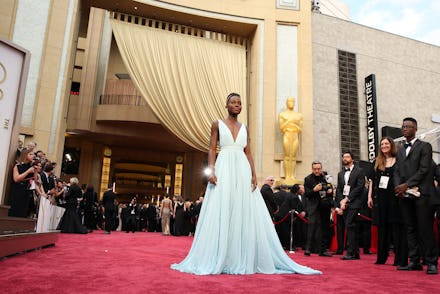Why is the red carpet red?

In the Greek tragedy Agamemnon, when the king returns home from war, his wife offers a “floor of crimson broideries to spread / For the King’s path.” In other words: a red carpet. The king is cautious — concerned, even — because supposedly only gods are allowed to walk down a “crimson pathway.” He is a mortal man, he says. Not a god.
That play was written in 458 B.C., giving us the first historical reference of the red carpet we know of. Now, nearly 2,500 years later, red carpets aren’t synonymous with godliness, but celebrity, fame, prestige and even royalty.
It’s no longer Zeus and Athena who we picture walking down a scarlet carpet, but Cate Blanchett and Lupita Nyong’o. The red carpet now brings up images of glamour and luxury and immense wealth, leading up to a private jet or awards show or movie premiere.
How did we get here? After the first recorded mention of the red carpet in Agamemnon, red carpets were often pictured in Renaissance art in portraits of wealthy families, who believably had the kind of wealth that could get them intricately patterned rugs.
“Red as a color has long been associated with prestige, royalty and aristocracy,” Sonnet Stanfill, a curator at the Victoria and Albert Museum, told the BBC. “Scarlet was among the most prized dyes as it was the most difficult to make and the most expensive.” So right off the bat, the color, like purple, was associated with high-class and prestigious people.
In 1821, the first reported red carpet in the U.S. was used in Georgetown, South Carolina, for the arrival of U.S. president James Monroe, laid before his riverboat, giving him a walkway onto the shore.
Then within the first few years of the 20th century, the term “red carpet treatment” was born via the railroads. An exclusive train called the 20th Century Limited, which was introduced in 1902 by the New York Central Railroad, according to the BBC, welcomed its passengers with a luxe red carpet, which lead them right onto the train.
But how did Hollywood catch on? That came in the 1920s, with the boom of the film industry. In 1922, the first reported Hollywood red carpet was used at a premiere of the film Robin Hood, starring Douglas Fairbanks, at the Egyptian Theatre. “The red carpet” was then considered the place to spot stars like Grace Kelly, Rita Hayworth and Marlon Brando.
It was iconic enough by 1953 that it was making regular appearances in film, like Gentlemen Prefer Blondes, starring Marilyn Monroe, cementing the association between it and glamour, fame, wealth and, yeah, women like Monroe.
In 1961, the first Oscars red carpet was rolled out at the Santa Monica Civic Auditorium and saw Elizabeth Taylor, Audrey Hepburn and Burt Lancaster all walking it.
In 1964, the broadcasters of the ceremony decided to start filming red carpet arrivals outside, as celebrities stepped out of their limousines and onto the carpet itself.
Why does this carpet exist at all? “The first purpose is that it would be an obvious guideline of where people would walk,” Hollywood historian Marc Wanamaker told the Los Angeles Times. “The other reason is that they didn’t want anyone slipping or falling going into the theater. The third reason is that it is glamorous.”
And why red? No one can be entirely certain, as there is not a governing body that oversees the myriad red carpets from movie premieres to presidential arrivals. According to the Los Angeles Times, it’s not exactly always red, but a kind of burgundy. But whatever color it is that day (the Oscars have a signature “Academy Red”) it undoubtedly has the ability to make dresses pop — from Cher’s sequined and see-through Bob Mackie outfit at the 1988 Oscars to Kate Middleton walking into the church on her wedding day in 2011 to Rihanna at the Met Ball in 2015.
The red, thousands of years after it was associated with gods and blood, is now only associated with glamour, fame and maybe a little bit of infamy too.
Though recent efforts have been made to upend the carpet’s signature color (see: the 2015 MTV Movie Awards’ blue carpet, the 2017 Billboard Music Awards’ pink carpet, the 2017 Met Gala’s cream and blue carpet or the 2017 CFDA Awards’ multi-colored carpet), red remains the norm.